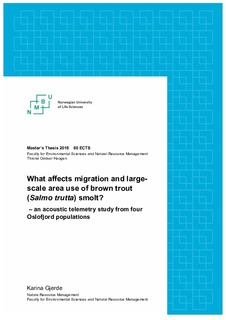| dc.description.abstract | The brown trout (Salmo trutta) is one of the most studied fish species, due to its recreational and economic value. The smolt life stage, is however less studied. In this thesis, I used acoustic telemetry to increase understanding of what affects migration and large-scale area use of four brown trout smolt populations from the rivers Årung, Lier, Sande and Selvik, all draining into the Oslofjord.
I hypothesized that increasing water discharge and temperature causes the brown trout smolt to migrate into the river mouth, which were supported by my findings. For large-scale area use, maximum distance travelled away from the river mouth were used as a measure. Previous studies have shown a positive correlation between body length and distance travelled away from river mouth. This was not the case for my study, where back-calculated length of 1st winter and condition factor and had a negative correlation with the maximum distance travelled.
Gyrodactylus salaris is a freshwater parasite on Atlantic salmon (Salmo salar), causing an 86% reduction of salmon parr in infected rivers in Norway. In laboratory experiments G. salaris have survived on brown trout for up to 100 days, hence brown trout can be a vector organism spreading the parasite. In my study, smolt individuals from G. salaris-infected rivers utilized river mouths of non-infected rivers, like the Aulivassdrag. Increasing flooding events of the Oslofjord can cause lower salinity and this might lead to a higher survival of the parasite when attached to seaward-migrating sea trout smolt, and thus increased risk of spreading to new river systems.
My findings show that what happens during the first years of the brown trout’s life in fresh water, does have an impact on how it later in life utilizes the marine system. This is of relevance to managers, who should have the entire life span of the brown trout in mind when making decisions affecting brown trout stocks. This study also shows that the large- scale area use of the smolt should be taken into consideration when determining methods for the potential elimination of G. salaris from Norwegian watercourses. | nb_NO |

